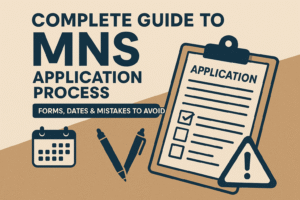What is the CLAT Exam?
CLAT (Common Law Admission Test) is a national-level entrance exam conducted in India for admission into undergraduate (UG) and postgraduate (PG) law programs offered by 22 National Law Universities (NLUs) and several other private and public institutions.
1. Who Conducts CLAT?
CLAT is conducted by the Consortium of National Law Universities, which includes the participating NLUs. The exam is usually held once a year, typically in December.
2. Courses Offered Through CLAT
✅ Undergraduate (UG) Program
BA LLB (Hons) – 5-year integrated law program
✅ Postgraduate (PG) Program
LLM – 1-year postgraduate law degree
3. Eligibility Criteria
🧑🎓 For UG CLAT:
Qualification: 10+2 or equivalent with minimum 45% (40% for SC/ST)
Age Limit: No age limit
🎓 For PG CLAT:
Qualification: LLB degree or equivalent with minimum 50% (45% for SC/ST)
4. Exam Pattern – CLAT UG (2025 Pattern)
| Section | No. of Questions | Weightage |
|---|---|---|
| English Language | ~22-26 | 20% |
| Current Affairs, including GK | ~28-32 | 25% |
| Legal Reasoning | ~28-32 | 25% |
| Logical Reasoning | ~22-26 | 20% |
| Quantitative Techniques | ~10-14 | 10% |
| Total | 120 Questions | 120 Marks |
Duration: 2 Hours
Mode: Offline (Pen-Paper)
Negative Marking: -0.25 marks for each wrong answer
5. Syllabus Overview – CLAT UG
📘 English Language
Reading comprehension
Vocabulary
Grammar and usage
🗞️ Current Affairs (GK)
National & International events
Awards, sports, appointments
Legal current affairs
⚖️ Legal Reasoning
Legal principles and scenarios
Application-based questions
Legal maxims (basic understanding)
🧠 Logical Reasoning
Arguments and conclusions
Syllogisms, analogies
Critical reasoning
➗ Quantitative Techniques
Basic maths (up to class 10 level)
Data interpretation
Arithmetic
6. CLAT PG Exam Pattern
| Section | Type | Questions |
|---|---|---|
| Constitutional Law | Objective | ~60 |
| Other Areas (Jurisprudence, Torts, IPC, etc.) | Objective | ~60 |
| Total | 120 Marks |
7. How to Apply?
Register online
Fill the application form
Upload required documents
Pay the fee (₹4,000 General, ₹3,500 SC/ST)
8. Top NLUs Participating in CLAT
NLSIU Bengaluru
NALSAR Hyderabad
NLU Delhi (via AILET, not CLAT)
WBNUJS Kolkata
NLU Jodhpur
GNLU Gandhinagar
NLIU Bhopal
HNLU Raipur
9. Career Options After CLAT
Corporate Law Firms
Civil Services (Law background helps in UPSC)
Judiciary Exams (Judge, Magistrate)
Legal Advisor in MNCs/NGOs
Litigation/Advocacy
Teaching and Academia
10. Preparation Tips
Start early (ideally in Class 11 or 12)
Read newspapers daily (especially The Hindu / Indian Express)
Take mock tests regularly
Practice past year papers
Focus on time management and accuracy
FAQs on CLAT Exam
Q1. How many times is CLAT conducted in a year?
Once a year, usually in December.
Q2. What is a good score in CLAT?
Scoring 85+ out of 120 can give you a good chance at top NLUs.
Q3. Is coaching necessary for CLAT?
Not mandatory, but coaching can help with strategy, mock tests, and expert guidance.
Q4. Can I write CLAT after Class 12?
Yes. You can apply in your 12th year or after completing 12th.
Q5. Is there a separate CLAT for PG and UG?
Yes, both have separate papers and syllabi.






